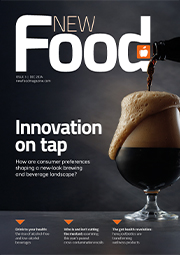Aroma and Flavour analysis in Food and Beverage Samples
- Like
- Digg
- Del
- Tumblr
- VKontakte
- Buffer
- Love This
- Odnoklassniki
- Meneame
- Blogger
- Amazon
- Yahoo Mail
- Gmail
- AOL
- Newsvine
- HackerNews
- Evernote
- MySpace
- Mail.ru
- Viadeo
- Line
- Comments
- Yummly
- SMS
- Viber
- Telegram
- Subscribe
- Skype
- Facebook Messenger
- Kakao
- LiveJournal
- Yammer
- Edgar
- Fintel
- Mix
- Instapaper
- Copy Link
The flavour and aroma of food and beverages is key for perception and acceptance by the consumer.
Gas Chromatography with Mass Spec detection is an effective tool to determine most of the key compounds involved and is finding increased adoption in recent years due to new techniques in sampling the volatile space above a sample. This webinar will guide you through the use of different headspace techniques, highlighting their benefits and limitations.
Relevant examples will be shown including beverage and food samples like distilled spirits, juices, brewed coffee, spices, nuts, bread, and food packaging.
- Headspace techniques such as static (SHS) or dynamic (DHS) headspace have an inherent selectivity for more volatile hydrophobic compounds but with less preference for hydrophilic and/or low vapour pressure compounds.
- The Full evaporation technique (FET) aims to completely evaporate the sample while leaving only the non-volatile matrix behind.
Hyphenation of dynamic headspace with thermal desorption GC/MS using a fully automated sequence of adsorption chemistries maximizes the analyte range.
With increasing levels of automation and sophistication, such techniques are allowing the food and beverage industry to achieve better and more efficient control of their products quality.
This webinar discusses:
- How to profile flavour compounds in matrix heavy samples while avoiding unwanted effects of non-volatile matrix materials
- How moisture problems can be addressed and eliminated (water management)
- Green sample prep: Extracting samples without the use of solvents
- Step by step when to use Headspace, Thermal Desorption, Dynamic Headspace, or sequential Dynamic Headspace and how a system can be set up to perform these techniques
- Which techniques you can use to obtain a full profile across the range of boiling points and polarities
- Maximizing the analyte range without sacrificing data quality
Keynote Speaker
Andreas Hoffmann, Manager Analytical Services, GERSTEL GmbH & co.KG


Andreas joined Gerstel in 1987 as application chemist and has more than 31 years of experience in developing applications based on automated sample prep techniques for GC/MS. He is head of analytical services at the Gerstel headquarters in Mülheim an der Ruhr, Germany.
The rest of this content is restricted - login or subscribe free to access


Why subscribe? Join our growing community of thousands of industry professionals and gain access to:
- bi-monthly issues in print and/or digital format
- case studies, whitepapers, webinars and industry-leading content
- breaking news and features
- our extensive online archive of thousands of articles and years of past issues
- ...And it's all free!
Click here to Subscribe today Login here
Related topics
Flavours & colours, Gas Chromatography/Mass Spec (GC/MS), Ingredients, The consumer








Dear Agilent,
I have been active during 40 years in the use of Agilent GC-MS and GC-mass fingerprinting and the relation with sensory analyses (using multivariate analyses and chemsensor ) for understanding flavor quality of all kind of food products: meat and meat products, dairy (cheese and milk in relation to packaging), alcoholic beverages (wine and distilled), roasted products (coffee, cocoa and chocolate).bob..
The ultimate goal was always to demonstrate the advantages of the analytical approach for measuring food flavor quality. As a consultant I have organised several seminars for the local food producers and food labs (in Dutch).
However, I think that these results could also be of interest for the international community and that due to the traditional character of food the results are still up-to-date (e.g. coffee to-day is not very different from the earlier coffee drinks)
Am I wrong that looking for webinars in that field I find very little information ?
So my question is would an analytical company like Agilent have interest in a cooperation for webinars in that specific field of objective flavor characterisation.
Prof. em. Patrick Dirinck
Odour and flavour consultancy
Graaf Van Landaststraat 152
9700 Oudenaarde
BELGIUM
Hi! Where is this webinar available for viewing on-demand? Thank you!
Hi Kawaljit, if you register using the link on the right-hand side page you will be able to access the on-demand webinar.
Thanks,
The New Food Team
Hi everyone. Just to let you know you can now watch this webinar on-demand. Please leave us any feedback in the comments section.